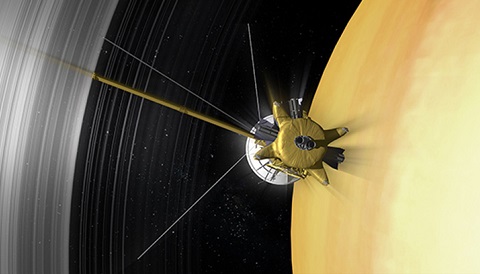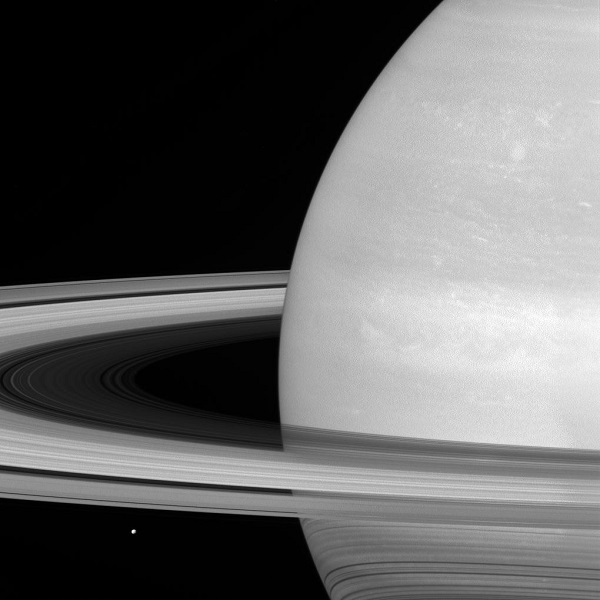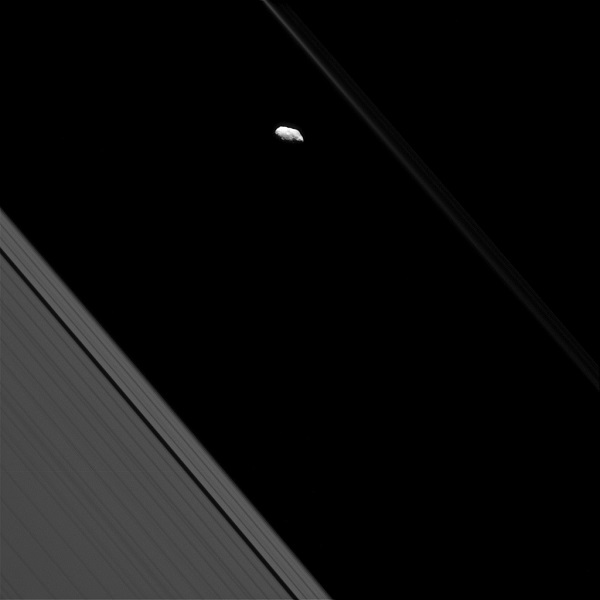Cassini's final main engine burn this weekend sets the stage for a stunning grand finale.

NASA / JPL / Cassini
After more than a decade exploring the ringed planet and its moons, NASA's Cassini spacecraft is preparing for a daring set of orbits which will set it up for mission's end later next year.
The recent 125th flyby of Saturn's giant moon Titan (T-125) was the prelude to Cassini's final acts, which will play out over the next year. That pass placed Cassini in a high-inclination orbit tilted 60° relative to the ring plane. Cassini will perform 20 passes just 620 miles (1000 kilometers) outside the F ring of Saturn in a phase known as the Ring-Grazing Orbits, which runs from late November 2016 through April 2017.

NASA / JPL / Cassini
Cassini already reached apoapse, or its farthest point from Saturn, on Wednesday, November 30th. The first ring crossing is coming right up this weekend on Sunday, December 4th, at 7:09 a.m. EST / 13:09 UT. During the first periapse pass on Sunday, Cassini will also burn its main engine for the 183rd and final time for the mission. All later fine course corrections will be made using thrusters only.
Things get even more interesting after April, when the series of Grand Finale Orbits will begin, taking the spacecraft through the 1240-mile-wide (2000-kilometer-wide) gap between the planet's cloud tops and rings for 22 final orbits. The Grand Finale Orbits start with the spacecraft's 126th and final pass near Titan, which will set the spacecraft up for much tighter final orbits.
After a mission spanning two full decades, Cassini is scheduled to burn up in Saturn's atmosphere on September 15th, 2017.
Saturn's Science Closeup
The interesting science returns will come from observations of the F and outer A rings. "The F-ring is amazing," says Cassini project scientist Linda Spilker (Jet Propulsion Laboratory). "500 kilometers wide, this ring is ever-changing with bright streamers and tenuous filaments sometimes flowing out from it. At other times, the moon Prometheus dips in and out of the F ring, creating channels in the ring material."
Three new science campaigns will get underway this weekend:
- Measurement of Saturn's magnetic and gravitational fields to probe the planet's internal structure and rotation rate;
- An evaluation on the total mass of the planet's ring system in an effort to determine its age;
- And finally, an analysis on the innermost radiation belts and possible direct sampling of the ring particles and Saturn's upper atmosphere.

NASA / JPL-Caltech / Space Science Institute
Cassini's Radio Science package will transmit towards Earth during each plane crossing, providing a long sweeping profile on each occultation pass. The spacecraft will also get great views of Saturn's poles, including the strange hexagon feature that graces the planet's north pole. Cassini's Visual and Infrared Mapping Spectrometer is set to chronicle its nine-hour passage over the north pole, giving us unparalleled views. Cassini will also measure the upper boundaries of Saturn's atmosphere in preparation for direct sampling on final passes late next year.
Cassini will target Saturn's moons as well. Expect to see closeups of the active ice geysers dotting the south pole of Enceladus one more time. Cassini will also image red-striped Tethys and the tiny shepherd moons Pan, Pandora, Atlas, and Daphnis, giving us the best views of these worldlets yet. Flybys of Pan and Daphnis occur in January and March respectively, from about 22,000 kilometers away.

NASA / JPL-Caltech / Space Science Institute
And speaking of moons, Cassini will be on the lookout for structures in the rings known as propellers, which betray the presence on tiny moons braiding and disrupting the rings. Scientists have named some of the propellers discovered so far after famous aviators, such as Amelia Earhart.
Cassini: Decades of Exploration
Launched atop a Titan IV rocket on October 15, 1997, Cassini arrived at Saturn on July 1, 2004 after a slingshot maneuver past Venus, Earth and Jupiter. The mission also delivered the European Space Agency's Huygens lander to Titan, which performed the most distant landing ever on January 14, 2005.
Powered by a plutonium-238 fueled Radioisotope Thermoelectric Generator (RTG), Cassini has delivered some amazing science.
“Two of Cassini's most astonishing discoveries are the global liquid water ocean on Enceladus, with possible hydrothermal vents on its seafloor which point to an ocean that may be habitable,” says Spilker. “The second is the lakes and seas of liquid methane at Titan's north pole and the incredibly Earth-like surface that we see on Titan.”
So enjoy this final year at Saturn: there isn't another mission to the ringed planet in the planetary exploration pipeline. The concept of a floating Titan Mare Explorer (TiME) was in the running during the last 2011 Planetary Decadal Survey, but never made it past the proposal stage.
It'll be a long time before we visit Saturn again.
 0
0









Comments
You must be logged in to post a comment.